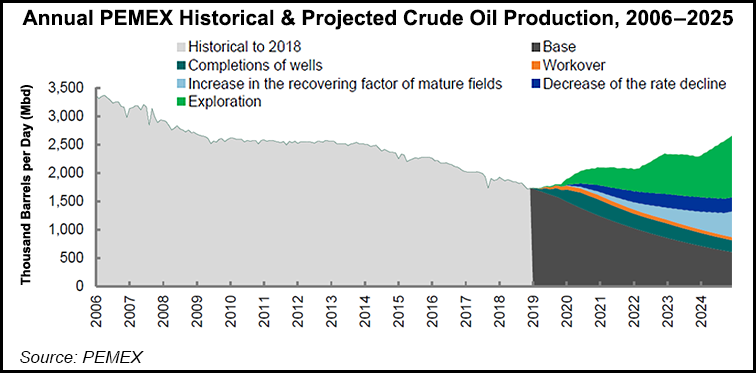Pemex Stabilizes Declining Oil Output, CEO Says
Crude oil production by Mexican state oil company Petróleos Mexicanos (Pemex) has stabilized after years of steady decline and will begin to rise again this year, CEO Octavio Romero Oropeza said Monday.

During President Andrés Manuel López Obrador’s regular press conference, Romero said “the decline has stopped,” citing that from March 9 until Monday (March 18), crude production averaged 1.683 million b/d, a “slight increase” from the amount produced on March 8.
The accelerated development of 20 fields in southeastern Mexico, comprising 16 in shallow water and four onshore, will allow Pemex output “to begin growing starting from this year,” Romero said.
Pemex produced 1.623 million b/d of crude and 3.696 Bcf/d of natural gas in January, down from an oil peak of 3.4 million b/d in 2004 and a natural gas peak of 6.516 Bcf/d in 2009.
Romero said Tuesday Pemex expects oil production to increase to an average of 2,480 b/d by 2024, and to reach 2,650 million b/d by the start of 2025.
However, Romero said, Pemex is forecasting nearly 1 million b/d of the total to come from discoveries made between now and then, an assumption that analysts have questioned in the past.
“Where is the lead time between discovery and first oil?,” Welligence’s Pablo Medina, vice president of research, asked Monday on Twitter.
A majority of Mexico’s natural gas production is associated with oil production. Romero said last December he expected gas output to rise 50% to 5.7 Bcf/d over the course of López Obrador’s presidency.
The 16 shallow water fields cited by Romero are off the coast of Tabasco and Campeche states in the Southeast. The four onshore fields comprise Chocol, Valeriana and Cibix in Tabasco state, along with the gas-heavy Ixachi field in Veracruz state.
Pemex said last November it expected Ixachi to supply 700 MMcf/d of gas and roughly 80,000 b/d of condensate by 2022.
The state-owned producer plans to drill 506 exploration and development wells in 2019, up from 162 in 2018, said Romero. He also accused the previous government of allocating a disproportionate amount of resources to deepwater exploration, which has not yielded “a single drop of oil.”
Gas Pipelines Facing Legal Action
Meanwhile, López Obrador said Monday state power utility Comisión Federal de Electricidad (CFE) has not ruled out legal action against the developers of seven natural gas pipelines that are currently delayed or inactive for reasons beyond the developers’ control.
López Obrador and CFE general director Manuel Bartlett have said it is “unfair” that CFE, which is the anchor shipper for all seven projects, must make fixed capacity payments to the developers for pipelines that the company cannot use.
Both men have said that the contracts between CFE and the developers must be renegotiated.
The delayed pipelines comprise Sur de Texas-Tuxpan, Tuxpan-Tula, Tula-Villa de Reyes, Guaymas-El Oro, La Laguna-Aguascalientes, Villa de Reyes-Aguascalientes-Guadalajara, and Samalayuca-Sásabe.
While the delays facing Sur de Texas-Tuxpan are mainly weather-related, the other projects face lawsuits and social opposition.
The president suggested that the developers could be “promoting” the conflicts “in order to maintain income in this way. I’m not affirming this categorically, but it’s one of the hypotheses that we have.”
© 2024 Natural Gas Intelligence. All rights reserved.
ISSN © 2577-9877 | ISSN © 2577-9966 |
